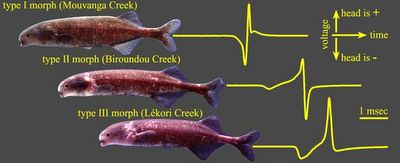
Credit: John Sullivan via Cornell University
From Sara Ball at CU Chronicle Online:
Electric fish in the Ivindo River in have different DNA, different communication patterns and won't mate with each other. However, two types of electric signals are now known from fish that have the same DNA.
The researchers' conclude that the fish appear to be on the verge of forming two separate species.
"We think we are seeing evolution in action," said Matt Arnegard, a postdoctoral researcher at Cornell U. Some of these fish violate an otherwise regular pattern of mating behavior, and so could be living examples of a species of fish diverging into separate species.
The electric fish -- known as mormyrids -- emit weak electric fields from a batterylike organ in their tails to sense their surroundings and communicate with other fish. Each species of mormyrid gives off a single characteristic electric impulse resulting in the flash of signals, indicating, for example, aggression, courtship and fear.
Because all of the 20 or so species of mormyrid have distinct electric signals, Arnegard believes the different impulses of the fish he studies might be their first step in diverging into different species.
One the other hand, the fish could be a single species. "This could be just a polymorphism, like eye color in humans, that violates the fishes' general evolutionary pattern but doesn't give rise to separate species," said Arnegard, who will return to Gabon in June to conduct further tests.